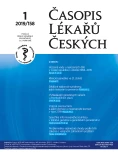-
Medical journals
- Career
Rare diseases in the year 2019 – the Czech and international context
Authors: Milan Macek jr.
Authors‘ workplace: Ústav biologie a lékařské genetiky 2. LF UK a FN Motol Praha
Published in: Čas. Lék. čes. 2019; 158: 33-37
Category: Review Article
Overview
Rare diseases (RD) are a clinically heterogeneous, predominantly inherited (or congenital) multisystem diseases with very low incidence in the general population that negatively affect the quality of life and social inclusion of affected patients and their families. The disease is defined as rare in the European Union if it affects less than 5 people out of every 10,000 citizens. There are approx. 5,000 different RD, implying an estimated total number of patients in Europe of approx. 20 million. RD most often manifest themselves soon after birth and affect up to 2–5 % of children but may occur also later in childhood or even in adulthood. About 80 % of RD have genetic pathogenesis, but most of them remain unrecognized or their causal gene remains unknown.
In this summary article we describe the current state of diagnosis and treatment of RD in the Czech Republic and at the European level. In addition, we will present the current issue of the development of international classification of diseases, the creation of domestic and international databases, the development of European and domestic recommendations, the implementation of a national strategy and three action plans for VO, the application of cross-border care, including the creation of European Reference Networks for these diseases and their impact on national legislation in terms of creation of highly specialized centers for RD in the country. The overall aim of this review is to not only map the state of art but also outline likely future developments in this rapidly developing field of modern medicine.
Keywords:
domestic and European professional recommendations – European reference networks – Genetics – international classification of diseases – national strategies – national action plan – cross-border care – rare diseases.
Sources
- Melnikova I. Rare diseases and orphan drugs. Nat Rev Drug Discov 2012; 11(4): 267–268.
- Fonseca DA, Amaral I, Pinto AC, Contrim MD. Orphan drugs: major development challenges at the clinical stage. Drug Discov Today 2019; 24(3): 867–872.
- Hoell JI, Warfsmann J, Distelmaier F et al. Challenges of palliative care in children with inborn metabolic diseases. Orphanet J Rare Dis 2018; 13(1): 112.
- www.orpha.net
- Kubáčková K. Vzácné nádory v onkologii. Mladá fronta, Praha, 2015.
- www.orphadata.org/cgi-bin/inc/product3.inc.php
- www.orphadata.org/cgi-bin/inc/product1.inc.php
- Lee VCY, Chow JFC, Yeung WSB, Ho PC. Preimplantation genetic diagnosis for monogenic diseases. Best Pract Res Clin Obstet Gynaecol 2017; 44 : 68–75.
- Forman J, Taruscio D, Llera VA et al.; International Conference for Rare Diseases and Orphan Drugs (ICORD). The need for worldwide policy and action plans for rare diseases. Acta Paediatr 2012; 101(8): 805–807.
- Balaščaková M, Holubová M, Skalická V, Zemková D et al. Pilot newborn screening project for cystic fibrosis in the Czech Republic: defining role of the delay in its symptomatic diagnosis and influence of ultrasound-based prenatal diagnosis on the incidence of the disease. J Cyst Fibros 2009; 8(3): 22–47.
- American College of Obstetricians and Gynecologists Committee on Genetics. ACOG Committee Opinion No. 486: Update on carrier screening for cystic fibrosis. Obstet Gynecol 2011; 117(4): 1028–1031.
- Castellani C, Macek M jr., Cassiman JJ et al. Benchmarks for cystic fibrosis carrier screening: a European consensus document. J Cyst Fibros 2010; 9(3): 165–178.
- Lao O, Lu TT, Nothnagel M et al. Correlation between genetic and geographic structure in Europe. Curr Biol 2008; 18(16): 1241–1248.
- www.orpha.net
- www.omim.org
- www.solve-rd.eu
- www.irdirc.org
- www.eurordis.org
- www.un.org/en/development/desa/population/publications/dataset/fertility/wfd2017.shtml
- www.omim.org
- www.ncbi.nlm.nih.gov/omim
- Fareed M, Afzal M. Genetics of consanguinity and inbreeding in health and disease. Ann Hum Biol 2017; 44(2): 99–107.
- http://new.slg.cz/pracoviste/
- www.novorozeneckyscreening.cz/vysledky-ns-2012-19-10-2015-131436
- www.czso.cz/csu/csu.nsf/informace/coby031411.doc
- www.detsky-lekar.cz
- www.vzacnenemoci.cz, www.orphanet.cz
- www.nkcvo.cz
- www.vzacna-onemocneni.cz
- www.vzacna-onemocneni.cz/images/ke-stazeni/plakat_vcasna_diagnostika_deti_25_02_2015.pdf
- www.vzacna-onemocneni.cz/images/ke-stazeni/plakat_vcasna_diagnostika_dospeli_25_02_2015.pdf
- www.vzacni.cz
- www.novorozenecky-screening.cz
- www.uzis.cz/cz/mkn/index.html
- http://cs.wikipedia.org/wiki/Guillaume_Duchenne_de_Boulogne
- www.who.int
- www.orpha.net/consor/cgi-bin/Disease.php
- Robinson PN, Mudnlos S. The human phenotype ontology. Clin Genet 2010; 77(6): 525–534.
- http://eur-lex.europa.eu/LexUriServ/LexUriServ.do?uri=OJ:C:2009 : 151 : 0007 : 0010:EN:PDF
- www.eu2009.cz
- www.eurordis.org/sites/default/files/publications/position-paper-EURORDIS-centres-excellence-networksFeb08.pdf
- www.mzcr.cz/dokumenty/vlada-schvalila-zpravu-o-plneni-narodni-strategie-pro-vzacna-onemocneni_15601_1.html
- www.who.int/classifications/icd/icdonlineversions
- www.uzis.cz/registry/narodni-zdravotni-registry/nr-reprodukcniho-zdravi
- www.registry.cz
- http://eur-lex.europa.eu/LexUriServ/LexUriServ.do?uri=OJ:L:2011 : 088 : 0045 : 0065:cs:PDF
- http://www.eurordis.org/IMG/pdf/position-paper-EURORDIS-centres-excellence-networksFeb08.pdf
- www.eucerd.eu
- http://ec.europa.eu/health/ern
- http://ec.europa.eu/health/ern/networks
- http://nestor.orpha.net/EUCERD/upload/file/EUCERDRecommendationCE.pdf
- www.mzcr.cz/Odbornik/dokumenty/evropska-referencni-sit-pro-vzacna-onemocneni_13637_3715_3.html
- www.ncmg.cz
- www.slg.cz
Labels
Addictology Allergology and clinical immunology Angiology Audiology Clinical biochemistry Dermatology & STDs Paediatric gastroenterology Paediatric surgery Paediatric cardiology Paediatric neurology Paediatric ENT Paediatric psychiatry Paediatric rheumatology Diabetology Pharmacy Vascular surgery Pneumology and ftiseology General practitioner for adults Pain management Dental Hygienist
Article was published inJournal of Czech Physicians

2019 Issue 1-
All articles in this issue
- Clinical genetics in the 21st century
- Congenital anomalies in children born in the Czech Republic in 1994-2015
- Hereditary cancer syndromes, their testing and prevention
- Implication of cytogenetic and molecular cytogenetic analysis in diagnosis of hematological malignancies in the era of the new sequencing techniques
- Searching for genetic variants associated with thrombophilia
- Rare diseases in the year 2019 – the Czech and international context
- Unique characteristics of informed consent in clinical genetics and genetic counselling
- Journal of Czech Physicians
- Journal archive
- Current issue
- Online only
- About the journal
Most read in this issue- Hereditary cancer syndromes, their testing and prevention
- Congenital anomalies in children born in the Czech Republic in 1994-2015
- Implication of cytogenetic and molecular cytogenetic analysis in diagnosis of hematological malignancies in the era of the new sequencing techniques
- Unique characteristics of informed consent in clinical genetics and genetic counselling
Login#ADS_BOTTOM_SCRIPTS#Forgotten passwordEnter the email address that you registered with. We will send you instructions on how to set a new password.
- Career

